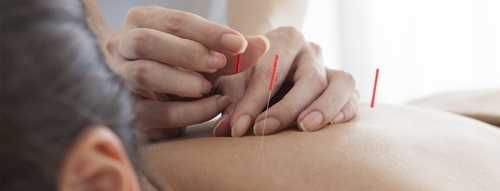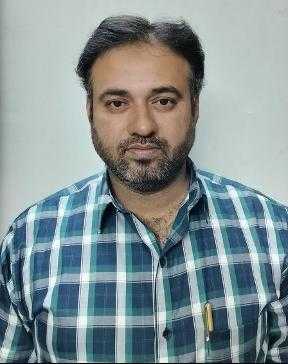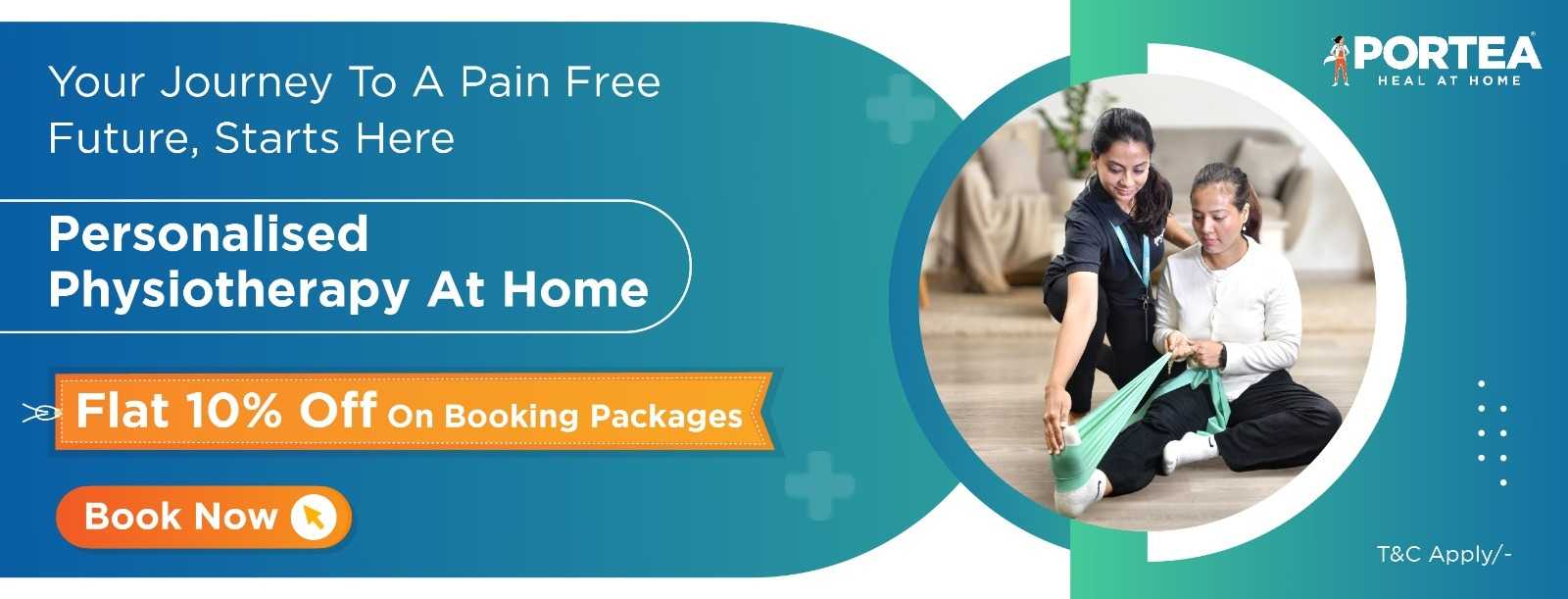
Expert Physiotherapy at Home
Certified physiotherapists visit you at home to provide focused, one-on-one care tailored to your needs. With no travel or waiting rooms, recovery happens in a setting that is comfortable, familiar, and built around your convenience.
Personalised Recovery Programmes
Every treatment plan is designed to suit your condition, goals, and pace. Our physiotherapists follow structured, evolving protocols to ensure consistent progress, with each session aligned to deliver meaningful results.
Trusted Physiotherapists. Real Results.
Our team comprises experienced, background-verified physiotherapists trusted by thousands of families. With a strong focus on safety, reliability, and clinical outcomes, we make recovery at home both effective and reassuring
Patient Testimonials
Portea Physiotherapists for Home Visits
Meet some of our experienced and dedicated healthcare professionals

Dr. Lokesh G
Physiotherapist
Specializations
Experienced in Neurological rehabilitation, Orthopaedic physiotherapy, and Paediatric care
Delivers structured, high-impact treatment plans across neuro, ortho, and paediatrics—ensuring safety, comfort, and measurable recovery at every stage.

Dr. Mohammed Sarwar
Physiotherapist
Specializations
Experienced in Neurological rehabilitation, Adult physiotherapy, and Paediatric care
Combines deep clinical expertise with a compassionate approach, supporting both adults and children through neuro and physical rehabilitation that promotes long-term independence and recovery.

Dr. Nelapati Divya
Physiotherapist
Specializations
Skilled in Orthopaedic rehabilitation, Manual therapy techniques, and Paediatric physiotherapy
Brings a personalised, hands-on approach to healing—combining structural expertise with paediatric sensitivity to restore movement, relieve pain, and improve everyday function.

Dr. Naveen V
Physiotherapist
Specializations
Trained in Pain management, Cardiac and Orthopaedic rehabilitation, Neurological care, and Neural tissue mobilisation
Brings clinical precision and empathy together—designing science-backed recovery protocols for pain relief, nerve mobilisation, and cardio-neuro-ortho rehabilitation across all age groups

Dr. Miloni Savla
Physiotherapist
Specializations
Holds an MPT in Orthopaedics with a focus on Musculoskeletal rehabilitation and strength recovery
Delivers focused, movement-oriented therapy grounded in orthopaedic science—helping patients rebuild strength, restore function, and return to daily life with confidence
Other Cities
Physiotherapy Treatments

how it works
The dry needling technique targets myofascial trigger points like tight muscle knots that cause pain or limit movement. Physiotherapists insert fine needles to stimulate a local twitch response, helping release tension and improve function. Since no medication is used, this therapy taps into the body’s neuromuscular response to aid healing and reduce discomfort.
benefits of dry needling
Dry needling therapy offers several advantages, especially when integrated into a comprehensive physical therapy program.
Pain Relief
One of the primary benefits of dry needling is its effectiveness in reducing both acute and chronic pain. By targeting myofascial trigger points, this technique can disrupt pain signals and reduce discomfort in affected areas.
Release of Muscle Tension
Dry needling in physiotherapy helps release tight muscle bands, improving flexibility and reducing stiffness. This can be particularly beneficial for individuals experiencing muscle spasms or knots.
Improved Mobility and Flexibility
The physiotherapy needling targets muscle tightness and trigger points, improves overall mobility, and helps with movement patterns.
Faster Recovery from Injuries
Dry needling therapy accelerates the healing process by increasing blood flow and reducing inflammation in injured tissues.
Support for Chronic Conditions like Fibromyalgia
For individuals with chronic conditions such as fibromyalgia, dry needling can help manage widespread muscle pain and improve quality of life.
common conditions treated with dry needling
Needling treatment is effective in managing various musculoskeletal conditions, including:
- Neck and Shoulder Pain: The therapy reduces tension and discomfort in the upper body.
- Lower Back Pain: Dry needle therapy for back pain targets deep muscle knots that contribute to discomfort, making it an effective option.
- Sports Injuries: Dry needling for sports injuries is a standard treatment for sports injuries, aiding in the recovery of strains, sprains, and overuse injuries.
- Tennis Elbow: Dry needling for tennis elbow has shown positive outcomes in reducing inflammation and pain in the elbow region
- Myofascial Pain Syndrome: Dry needling for myofascial pain syndrome is widely utilised for addressing chronic pain associated with trigger points.
- Headaches and Migraines: Dry needling for headaches and migraines relieve tension in the neck and shoulders that can lead to headaches.
- TMJ (Jaw Pain): Dry needling for TMJ pain eases muscle tightness, contributing to temporomandibular joint discomfort.
what to expect during a dry needling session
Understanding the process of dry needling therapy can help alleviate concerns and set appropriate expectations.
Before the Session
Patient Assessment and Discussion of Medical History
Your physiotherapist will conduct a thorough dry needling patient assessment, discussing your medical history, current symptoms, and treatment goals to determine if dry needling is appropriate for you.
During the Session
Needle Insertion and Duration
Thin, sterile needles are inserted into identified trigger points. As the muscle responds, you may feel a brief twitch or cramp. Sessions typically last 15 to 30 minutes, depending on the treatment area and individual needs.
After the Session
Possible Soreness or Bruising
Mild soreness or bruising at the needle sites is common and usually subsides within a day or two. These are typical dry needling side effects and are generally short-lived.
Stretching and Hydration Encouraged
Gentle stretching and staying hydrated are recommended post-treatment as part of aftercare for dry needling to aid recovery and enhance the session’s benefits.
When to Contact Your Provider
If you experience unusual or prolonged discomfort, it’s important to reach out to your physiotherapist for guidance.
risks and side effects of dry needling
Dry needling is generally safe when performed by a licensed dry needling physiotherapist. However, like any physical therapy technique, it can have some side effects and contraindications.
- Mild Soreness, Bleeding, or Bruising
These are the most common side effects of dry needling. The treated area may feel tender or slightly bruised, but symptoms usually subside within a day or two. - Infection Risk from Dry Needling
This is rare, especially when sterile, single-use needles are used. Following hygienic practices significantly reduces the risk.
Tip: To minimise any dry needling side effects and risks, always consult a licensed dry needling physiotherapist and disclose your medical history beforehand.
who should avoid dry needling?
Dry needling may not be appropriate for:
- People with Bleeding Disorders: Increased risk of bleeding or bruising.
- Pregnant Women: Dry needling during pregnancy is generally avoided, especially in the first trimester, or is done only under strict medical supervision, avoiding specific points.
- Individuals on Blood Thinners: Higher likelihood of bleeding complications.
- Those with a Fear of Needles: May experience heightened anxiety or discomfort.
Always consult with a healthcare professional to determine if dry needling is suitable for your specific situation.
is dry needling effective? what does the research say?
Clinical studies on dry needling have demonstrated its effectiveness in reducing pain and improving function for various musculoskeletal conditions. A systematic review and meta-analysis published in the Journal of Orthopaedic & Sports Physical Therapy supports the use of dry needling to improve pain and functional capacity in patients with chronic neck pain at short- and mid-term intervals.
Additionally, a clinical study published in Scientific Reports found that dry needling effectively reduced pain intensity and improved functional efficiency in patients with chronic low back pain.
where can you get dry needling treatment?
Dry needling physiotherapy by Portea offers expert care directly to your home. Our licensed physiotherapists provide safe and effective dry needling treatment at home, using the latest techniques tailored to your needs. Experience the convenience and comfort of home dry needling services with our expert team, ensuring personalised care in your own space.
faqs about dry needling
1. Is dry needling painful?
Most patients feel only a brief twitch or cramp during needle insertion. Any soreness usually fades within 24 to 48 hours.
2. How many sessions will I need?
Sessions vary by condition and response. Your physiotherapist will create a personalised plan for you.
3. Can dry needling help with sciatica?
Yes, it helps relieve muscle tension and pain linked to sciatica, especially as part of a complete physiotherapy program.
4. How is dry needling different from trigger point massage?
Dry needling uses needles to stimulate muscles directly and may cause a twitch. Trigger point massage uses manual pressure to ease tension.
Doctor Consultation
Nursing
Physiotherapy
Trained Attendant
Elder Care
Mother & Baby Care
Lab Tests
Medical Equipment
Speciality Pharma
Critical Care




